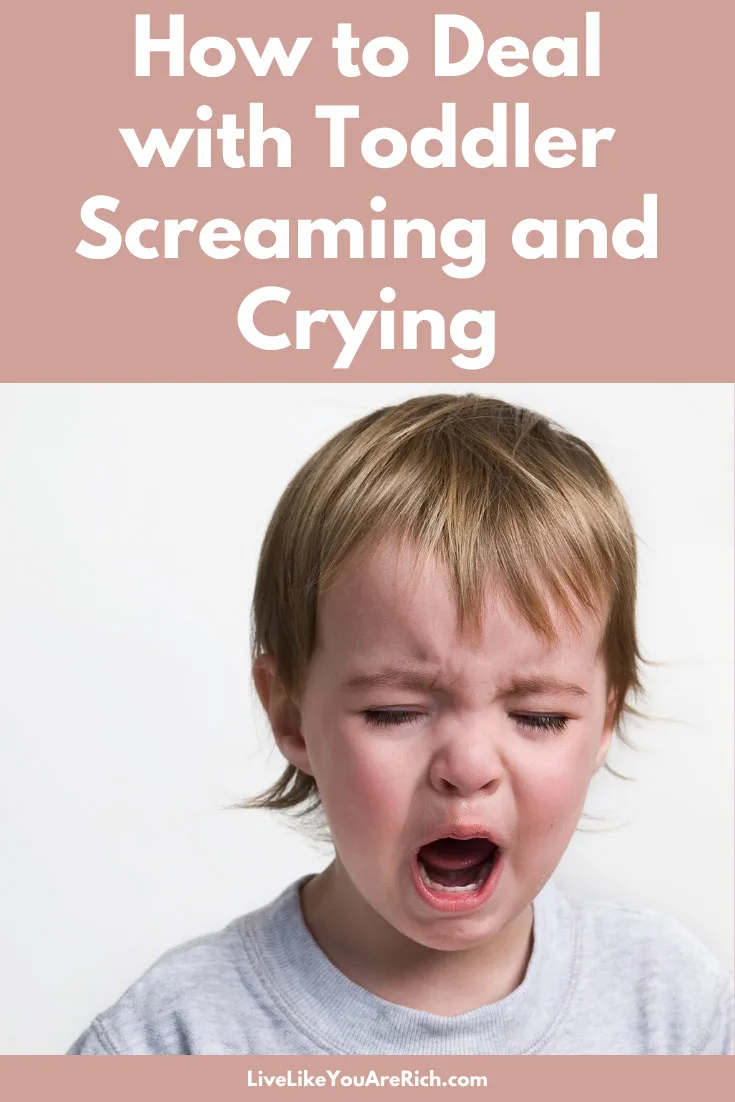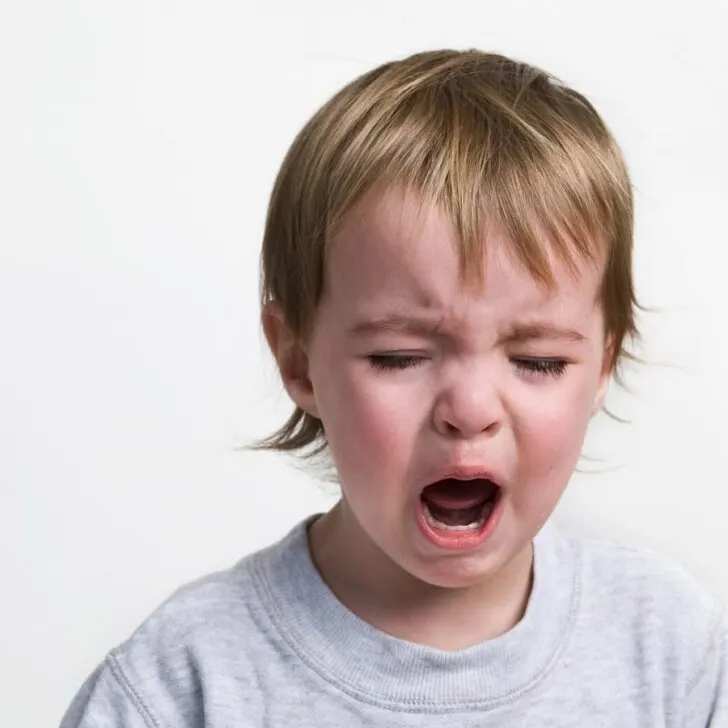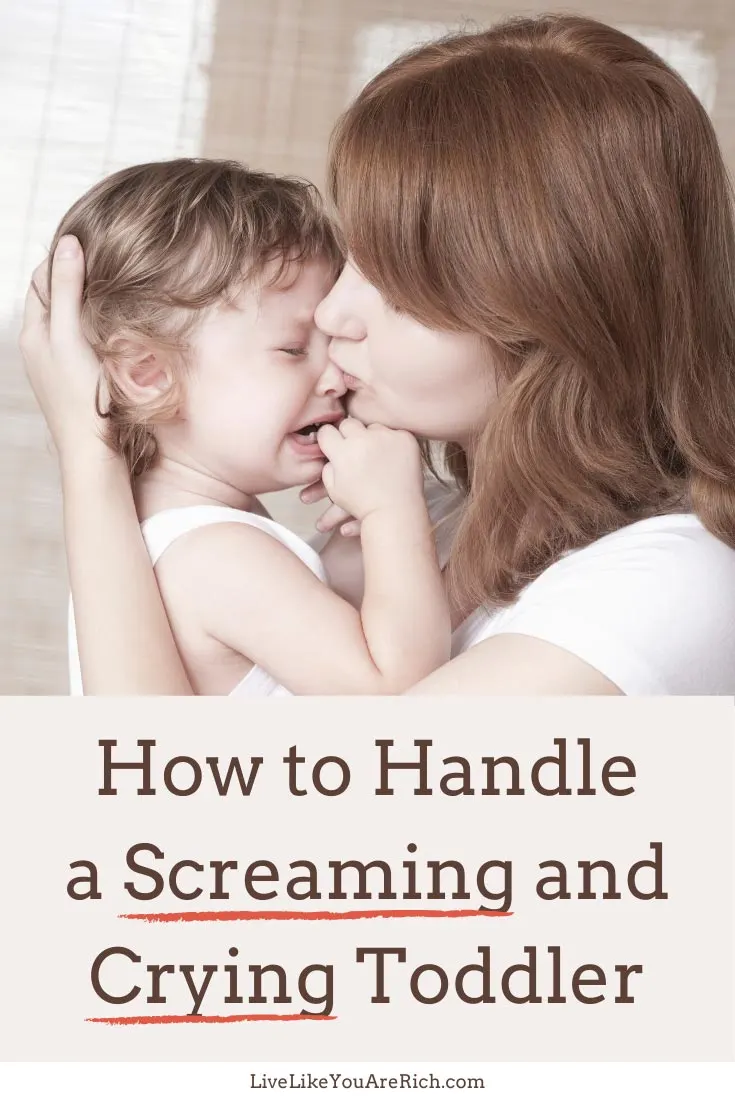I love being a mother. But it can get downright tough. I always looked at toddlers that were having huge major meltdowns and thought to myself, ‘man I hope that my kid isn’t like that’. Well, now I have one who is exactly like that. Of course, I love him to pieces but man can he scream!
Note: I published this post a few years ago. I am republishing it so that new readers have a chance to see older content.
And he melts down at just about anything. He cries if his granola bar breaks in half. He screams if he drops his fork and I replace it with an identical one. If he is wearing a shirt for bedtime and doesn’t want to take it off when I change him in the morning, we experience a huge meltdown, etc.
Usually by the time breakfast is over he’s already cried, shrieked, screamed, and melted down over a handful of times because of things I feel are fairly meaningless. After a few months of this, I read up on why these toddlers cry so much. I pretty much read what I knew in the first place…
I know he has the best of intentions. I know that he’s a smart boy just frustrated with his limited vocabulary and difficulty expressing himself. He has big emotions in a small body and it’s difficult for him to handle them. He’s just trying to figure everything out. And just when he thinks he has it figured out, his fork drops, or he has to change his favorite shirt. Eighteen months to about three and a half is a tough time for our little ones. Some toddlers have much more difficulty with it than others (our son is one of them). I guess that’s why they call it the ‘terrible two’s’.
When we see the frustration starting to build, we do the following:
- I tell Denali (our 2 1/2 year old) to ‘use his words’. I even sing the song from Daniel Tiger, “Use your words, use your words”. On occasion, he will use them and we avert a meltdown.
- We give him 2-3 choices between clothes and colors, fork or spoon, and other items. This works about 40% of the time.
- We make something he needs to do sound and seem super fun like putting on shoes, or his jacket. For example, we will say, “Wow look at those awesome, amazing Lighting McQueen shoes! Mom has her shoes, dad has his shoes, Denali do you want to put on your awesome light up shoes on and be like mom and dad?” Yes, it’s a mouthful, but if we act excited and use good tones he will quite often comply.
- We try to let the non-essentials slide. For example, if he wants strawberries instead of blueberries, we give him the strawberries. If he wants to play with a non-toy that won’t hurt him or break easily, we let him. I once heard a quote that says, “Whenever possible, say yes; they are only kids once!”—Majorie Pay Hinckley. Having this attitude and doing my best to say yes instead of no all of the time helps too.
- We are firm on nap time. Often he becomes too tired to handle his emotions and needs to recharge. Naptimes are lifesavers, if refused, he stays in his room for quiet time for at least an hour or two and then goes to bed a little earlier than normal.
- We set up plenty of play dates with other kids. Denali is a strong-willed social boy who loves to be around others. Playdates (although he will have some melt-downs or cry-outs) usually help him burn off energy, learn, socialize, and feel special.
- We have him go to timeout for when he misbehaves. He has to stand with his head towards the wall for about a minute or two. Timeout is especially effective for him!
- We teach him. We ask him to look us in the eyes, (we kneel down so we are at his level) and teach him that what he is doing or perceiving may not be the most correct. For example, we tell him he needs to share his crayons with his friend he is coloring with. Or we explain that the granola bar is okay even if it is broken, etc. This is suggested by many professionals but I can say that with our son, honestly, it rarely works. Maybe one day it will, I keep trying it hoping it will.
- We limit TV time. I’ve noticed if we limit the time he spends watching TV he is better behaved.
- We tell him what is happening during the day. For example, “We will eat breakfast, then brush teeth, and after that, we will go to the grocery store.” This helps him to know what is happening and feel more in control. I’ve noticed a big difference on days when I do and do not do this.
- We make sure to have one-on-one time and family time (without electronics). I take him on mommy-son outings often. Dad takes him out too. I read to him alone, have tickle wars, jump on our in-ground trampoline together, etc. By doing this we are trying to show and remind him (that despite growing older and having a little sister), we will always love him. One-on-one time really helps to reduce his meltdowns.
YET, even doing our best and implementing all of these tactics often, we still experience multiple crying, screaming, and whining episodes each and every day.
I asked my sister what she does because her son easily wins the award for crying episodes (and my sister easily gets the patience award for dealing with the crying these past few years). She told me what she found to really help combat the meltdowns was making a designated ‘crying chair’. When their son was crying (and wasn’t in trouble) he was sent to sit on the crying chair. As soon as he was done crying he was allowed to get off. After a day or so he realized what was going on. He only went and sat on the crying stair when he was crying. He wasn’t being punished, he was simply being asked to sit and calm down. It’s really helped him to learn to calm down quickly and understand that having a meltdown isn’t the proper way to handle his emotions.
So we began doing this with our 2 year old Denali. He has a crying step and it is the top step in our garage or the bottom step on our back patio (the reason why it is outside is so he can calm down without waking up our baby—which has happened too many times to count). In the winter we will change the location.
So, I take him or send him (he can open the door) out to the garage and he sits on the top step. There he can scream and cry all he wants without waking up our baby, and because the door muffles the noise I don’t get overly upset about the crying either. I stay near the door and as soon as he is done crying he is allowed in. He can also choose to let himself in. He stands up and opens the kitchen door or back door and comes inside, but only after he is finished crying (and he obeys that rule). After implementing this for the last few months, I can without hesitation say it has been a sanity-saver!
This is not a punishment. We do not send him onto the crying stair for hitting, spitting, biting, etc. He goes to timeout for those grievances. He only goes to the crying stair when he is crying over something that hasn’t broken a rule.
The crying stair is working so well that he already starts to calm himself down on his way to it. It’s pretty amazing how much better he is getting at calming himself down and self-soothing. It’s not perfect but we are having to use it less than when we started.
We are so happy my sister gave us this advice. Not every child will need a crying stair/chair. But if you have one who, despite your best efforts and implementing many of the tips I shared above, cries or screams incessantly, it may work for you as well as it does for us!
UPDATE- Our son has made a ton of progress over the past year and we have had to use the crying stair less and less. Often, when he is having a tantrum all I have to say is ‘do you need to go to the crying stair?’ and he will calm himself down. I know that some of the improvement is also due to him growing up. When he turned three is it like a light went off and despite there still being a tantrum here and there, they are occurring less often and the crying stair (mentioning it or sending him to it) stops them quickly.
For other ‘rich living’ and parenting tips please subscribe, like me on Facebook, and follow me on Pinterest and Instagram.

SUBSCRIBE FOR OUR EMAILS





Audria Allred
Monday 27th of March 2017
This is a great article! I have tantrums with my toddlers and have tried various things but nothing has seemed to help! I will definitely be trying these! Thank you.
Anita Fowler
Monday 3rd of April 2017
Thank you Audria- good luck!
Chelsea
Thursday 29th of December 2016
Great idea! I like this to teach that we are allowed to be upset, but then he must learn to calm himself down! It's nous parents fixing the problem, its the kid learning to calm himself from whatever had upset him! Thanks for the read, very insightful!
Anita Fowler
Thursday 29th of December 2016
You are very welcome. Thank you for the kind feedback.
A.S.
Wednesday 26th of October 2016
Thankyou!!! This is a really helpful article that uses boundaries and firm guidelines AND just common sense (less tv time, pre-information of the daily routine, one-on-one time). I think most of us understand why our toddlers are throwing tantrums but there seems to be a lot more advice out there on why rather than useful advice on how to lovingly and firmly combat it - our little guy has just hit 18 months old and oh boy are we in for some interesting days! (My Mum seems to recall similar with me as a toddler..haha). It's nice to know we're all in this together! Will definitely be trying the 'cry pillow' - thank you so much!!!
Anita Fowler
Thursday 27th of October 2016
You're welcome! Thanks for stopping by!
Katie c
Sunday 17th of January 2016
lovely article! One other trick is to give expectations for the events happening throughout The day so he maintains a since of control and confidence. warnings like "first we are eating breakfast then brushing are teeth then going to the park" may help too!
Anita Fowler
Sunday 17th of January 2016
Katie- That is such a good tip. I can't believe I forgot to add it. When I do that, I do notice he is better prepared and has fewer breakdowns. I'll add that to the article.
Mama Carmody
Thursday 14th of January 2016
This is wonderful advice. My daughters are grown and now we are helping with our grandchildren. Your advice is spot-on. I used just about every one of your techniques. We actually used the same step for time outs and for crying fits. Actually our time outs were usually limited to whenever they stopped crying and could come apologize. We also believed in spanking for those absolutely defiant times. James Dobson gives some wonderful advice.
Anita Fowler
Thursday 14th of January 2016
Thank you so much Mama Carmody. That is such a nice comment. I appreciate it. Sounds like you were a great parent and now an amazing grandparent. It really helps us as parents when the grandparents are firm and discipline too. If not, you have to retrain and remind them after they visit grandma and grandpa. My parents keep our kids in line and it is really nice.